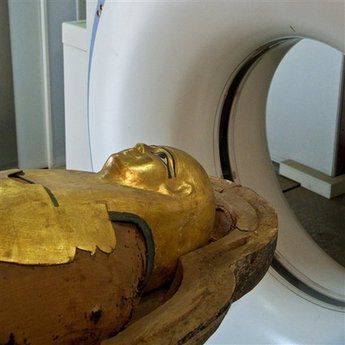
This undated photo provided by Dr Michael I. Miyamoto shows the mummified remains of Djeher, who lived in the Ptolemaic Era (304-30 BCE), entering a CT scanner tube set up outside of the Egyptian National Museum of Antiquities in Cairo.[Agencies]
ORLANDO, Fla. – You can't blame this one on McDonald's: Researchers have found signs of heart disease in 3,500-year-old mummies.
"We think of it as being caused by modern risk factors," such as fast food, smoking and a lack of exercise, but the findings show that these aren't the only reasons arteries clog, said Dr. Randall Thompson, a cardiologist at the Mid America Heart Institute in Kansas City.
He and several other researchers used CT scans, a type of X-ray, on 22 mummies kept in the Egyptian National Museum of Antiquities in Cairo. The subjects were from 1981 B.C. to 334 A.D. Half were thought to be over 45 when they died, and average lifespan was under 50 back then.
Sixteen mummies had heart and blood vessel tissue to analyze. Definite or probable hardening of the arteries was seen in nine.
"We were struck by the similar appearance of vascular calcification in the mummies and our present-day patients," said another researcher, Dr. Michael Miyamoto of the University of California at San Diego. "Perhaps the development of atherosclerosis is a part of being human."
One mummy had evidence of a possible heart attack but scientists don't know if it was fatal. Nor can they tell how much these people weighed — mummification dehydrates the body.
Of those whose identities could be determined, all were of high social status, and many served in the court of the Pharaoh or as priests or priestesses.
"Rich people ate meat, and they did salt meat, so maybe they had hypertension (high blood pressure), but that's speculation," Thompson said.
With modern diets, "we all sort of live in the Pharaoh's court," said another of the researchers, Dr. Samuel Wann of the Wisconsin Heart Hospital in Milwaukee.
The oldest mummy with heart disease signs was Lady Rai, a nursemaid to Queen Ahmose Nefertari who died around 1530 B.C. — 200 years before King Tutankhamun.
German imaging company Siemens AG, the National Bank of Egypt and the Mid-America Heart Institute paid for the work. Results are in this week's Journal of the American Medical Association and were reported Tuesday at an American Heart Association conference.
taken from : China Daily



No comments:
Post a Comment